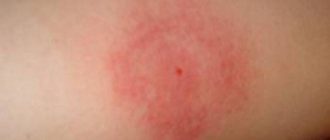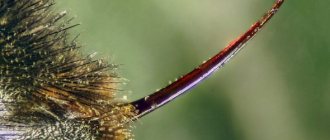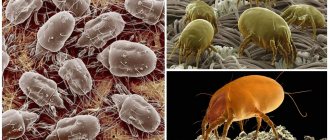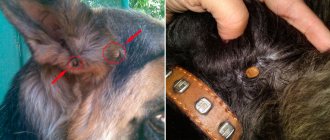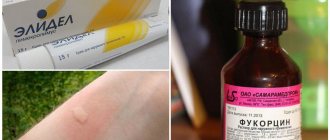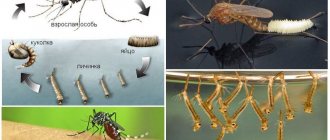Spread of ticks
By attaching themselves to birds or animals, parasites can expand their habitat over many kilometers, although they can only cover a few meters on their own. Ixodid ticks are common in the temperate zone of Eurasia, and taiga and dog parasites can be observed both in Siberia and in the regions of the Far East and the Baltic states.
The lifespan of a tick depends on the species. For example, house dust mites or dust mites live 65-80 days. Other species, such as the taiga tick, live up to 4 years. Without food, ticks can live from 1 month to 3 years.
General description of ticks
Ticks belong to the subclass of arthropods of the arachnid class. The mite order has more than 54,000 species. By size they are classified as small, small and microscopic spiders. Their size allowed them to settle into the top layer of soil, rich in decaying organic matter, which led to such a diversity of species.
Appearance
Ixodid tick photo
The structure of mites is not diverse. Animal and domestic ticks have undergone some internal changes compared to their wild counterparts. These arachnids have both a non-segmented body and an oval or spherical body divided into an abdomen and head. It is covered with hard chitinous plates or shell. Ticks have 6 pairs of limbs, the first 2 form a kind of proboscis, the remaining 4 are used for movement. The first pair has a claw-like shape; under a microscope, the mite resembles a kind of crab (photo is provided).
All ticks are divided into 2 sexes; development occurs with metamorphosis. Ticks reproduce at different rhythms depending on living conditions. The first stage is the laying of eggs, from which the larvae emerge. During its development, the tick larva molts several times. After the first molt, she enters the nymph stage, after the last she is considered mature (imago). Different types of ticks at the larval stage go through several periods of transformation, marking the next stage of development. Ticks reproduce where they live. Ticks feed on liquid or semi-liquid food.
Nutrition and threat to humans
The vast majority of arachnids are free-living in the natural environment; only a few species of ticks live off humans. Parasites feed on the blood or biological material of people and animals; so-called saprophages consume plant or animal remains. Some types of mites prefer living plants.
House ticks have adapted to living near humans or on their bodies. Most ticks live in natural conditions, including the most dangerous species - the taiga tick (also known as the ixodid tick). It is he who is the carrier of many dangerous diseases. Ticks choose damp places, ravines, and prefer tall, dense grass and shady places. Having a good sense of smell, they set up ambushes along forest paths. Information about where ticks live, what types of ticks are found specifically in your area, which areas are treated and safe, and when the highest tick activity is achieved can be obtained from the sanitary and epidemiological station.
Bottom view of a tick
Ticks are most active in May and June. It is believed that in September the taiga tick and other types of parasites dangerous to humans and animals no longer attack and do not pose a danger. Are ticks dangerous in the fall? In fact, activity directly depends on weather conditions. Warm summers and autumns significantly prolong the period of tick activity, which may end in October, although bites are especially dangerous in spring and early summer. It is safe to say that ticks do not attack or be active in winter in any case, but the full range of “hunting” is recorded from April to November.
At what temperature ticks die depends on the living conditions. When ticks are outside the donor’s body, they can die at a temperature of +7ºС…+14ºС within 2-3 weeks, at +60°С - within an hour. In cold weather, the parasites go into suspended animation and lay eggs in the spring, thereby completing their life cycle. Where ticks overwinter also depends on the conditions and the specific species. In the natural environment, they burrow into the grass and leaves of the ground layer. This allows you to overwinter at the lowest temperatures. Life expectancy, depending on the species and taking into account periods in suspended animation, can reach 10 years.
How dangerous are ticks to humans? The likelihood of transmitting serious diseases acquired from wild animals through saliva is too high. The activity of ticks in the spring-summer period leads to the fact that in Russia 2000-3000 people become infected with encephalitis per year. A tick bite can also cause:
- epilepsy and hyperkinesis;
- Lyme disease (borreliosis);
- nephritis;
- arthritis;
- indigestion;
- blood pressure surges and arrhythmia;
- pneumonia or pulmonary hemorrhage;
- complete loss of legal capacity and ability to move and care for oneself (in the worst cases).
Description
The tick (lat. Acari) is one of the oldest inhabitants inhabiting our planet. Contrary to erroneous belief, ticks are not insects, but are representatives of the arachnid order.
These representatives of arthropods rarely reach 3 mm in size; the size of mites generally ranges from 0.1 to 0.5 mm. As befits arachnids, ticks lack wings. Adult ticks have 4 pairs of legs, and specimens that have not reached sexual maturity have three pairs of legs. Having no eyes, ticks navigate in space using a well-developed sensory apparatus, thanks to which they can smell the victim 10 meters away. According to the structure of the body, all types of ticks can be divided into leathery ones, with fused head and chest, and hard (armored) ones, in which the head is movably attached to the body. The supply of oxygen also depends on the structure of the body: the former breathe through the skin or trachea, while armored animals have special spiracles.
If the tick's head remains in the body
If a tick is decapitated during its removal, this will be visible as a black dot at the site of the bite; swelling, slight swelling, and possible discharge of pus may appear on the damaged area of the skin. The bite site must be treated with chlorhexidine for external use several times a day. In rare cases, if the head of the tick remains in the body, there may be a pronounced inflammatory reaction at the site of the bite, characterized by large swelling, increased temperature and copious discharge of pus. The tick's head remaining in the body does not affect the likelihood of illness, since infection occurs at the time of the bite due to bacteria in the parasite's saliva. If the head of the tick remains in the body, and a skin abscess (a pus-filled lump the size of a large pea) appears at the site of the bite, the boil can be pierced with a disinfected needle, the head of the tick should come out of the body along with the pus. The site of the abscess must be disinfected with antibacterial cream or special ointment, sold at any pharmacy.
What do ticks eat?
According to their feeding method, ticks are divided into:
- Saprophages feeding on organic debris. Saprophages provide benefits by participating in the formation of humus. Feeding on plant sap, parasitic mites cause enormous damage to agriculture; in addition, they can destroy grain or flour reserves. Dust and scabies mites feed on exfoliated particles of the human epidermis. Granary mites eat rotting plant debris, flour, and grain. Subcutaneous mites feed on the fat found in human hair follicles. Spider mites drink plant juices. Ear mites feed on oil from the ear canals.
- Predators that parasitize animals and plants
Predatory blood-sucking ticks wait for their prey, lying in ambush on blades of grass, twigs and sticks. Using paws equipped with claws and suction cups, they attach to it, after which they move to the feeding site (groin, neck or head area, armpits). Moreover, the victim of a tick can be not only a person, but also other herbivorous ticks or thrips.
A tick bite can be very dangerous, since ticks are carriers of diseases, including encephalitis. Ticks can survive without food for up to 3 years, but at the slightest opportunity they show miracles of gluttony and can increase in weight up to 120 times.
What danger do forest ticks pose to humans?
The small size of the forest tick should not fool you into thinking that these parasites are quite harmless insects. In order to understand the danger forest ticks pose to humans, it is enough to list some of the diseases that bloodsuckers can transmit through a bite.
First of all, forest ticks can infect:
- Borreliosis, also known as Lyme disease
- Rickettsial disease
- Viral fever
- Encephalitis
- Tick-borne typhus
- Tularemia
- "Tick paralysis"
And this is not the entire list. You will be surprised, but forest ticks can cause about sixty different diseases. In addition to people themselves, domestic animals, including dogs, cats and horses, can also be affected. And even though a person is often successfully cured, there are diseases that can be fatal. One of these may be encephalitis, since in severe forms of the disease the brain becomes inflamed, which often causes death. But even with successful treatment, certain complications of a psychiatric or neurological nature may occur.
Borreliosis, which is infectious in nature, has recently become widespread. The person experiences severe headaches, a fever sets in and overcomes a feeling of apathy. The disease is also characterized by the appearance of a skin rash over the body, the so-called erythema migrans. If treatment is not started immediately, complications may occur that can lead to disability.
Taking into account all the above data, it is better, after detecting a forest tick bite, to contact the appropriate sanitary and epidemiological station departments to make sure that nothing threatens you. Otherwise, this will help to start treatment in a timely manner.
Description of the main types of ticks
Ixodid ticks
The body of adult individuals is covered with hard chitinous plates and is quite impressive in size - ticks of this species often reach 2.5 centimeters in length. Ixodid ticks live in latitudes with temperate climates, found in the foliage of trees and various shrubs throughout the entire Eurasian continent. This type of tick “happy” parasitizes forest and domestic animals, cattle, and does not disdain humans: having attached itself to the skin of its victim, it is ready to feed on blood from several days to 2-3 weeks. The female ixodid tick is very fertile and is capable of laying 17 thousand eggs per season.
Argasid mites
They live in the cracks of houses and outbuildings, often living in abandoned bird nests. They parasitize domestic animals and poultry; they give particular preference to chicken coops; they often attack humans. A tick bite is quite painful, followed by severe itching and a profuse rash at the site of the lesion. The parasite has soft, leathery coverings, and its head is significantly recessed into the inside of the body, making it barely noticeable.
Armored mites
They mainly live on the soil, although there are also species that prefer to live in trees. As such, oribatid mites do not have parasitism: their food is living plants, mushrooms, lichens and their plant remains; they do not disdain carrion. However, the oribatid tick poses a danger to animals and birds, as it is a carrier of helminths, in particular tapeworms.
Gamasid mite
It chooses bird nests, chicken coops and rodent burrows - mice and rats - as its place of residence, because it parasitizes their owners. The lifespan of this small mite (dimensions do not exceed 1 mm) is approximately 6-7 months, but even in such a short period of time it causes great damage to poultry farms, causing feather loss in chickens and huge scratches on the skin with its toxic saliva.
Subcutaneous mite
It parasitizes animals and humans, living on their bodies for several years and feeding on dead skin cells, causing unbearable itching and irritation in its “host”. The female subcutaneous tick lives for 2.5 - 3 months, laying up to 80-120 eggs during this time, from which viable nymphs appear within a couple of days.
Scabies mite
A parasite that causes an unpleasant and sometimes difficult-to-treat disease - scabies. It causes a lot of trouble for both animals and humans, making tiny passages in their skin, feeding on skin secretions and causing severe itching and redness. The lifespan of this mite varies from 1 to 1.5 months, but within a given period the female manages to lay eggs repeatedly.
Ear mite
The main “breadwinners” of this parasite are cats and dogs. It is safe for humans, but it gives animals a lot of unpleasant sensations in the form of scratching of the ears with subsequent inflammation.
Dust mite (bed, linen)
It does not parasitize living organisms, as it feeds on exfoliated epidermis, accumulations of dust, fluff or feathers. It is one of the causes of asthma in humans. This type of tick is quite prolific: in four months of life, the female lays about 350 hundred eggs.
Spider mite
It is absolutely harmless to birds, animals and humans, since it is a complete “vegetarian” and feeds on plant juices, settling on the bottom of the leaf and sucking the juices out of it. It is a carrier of gray rot, which is destructive for plants.
Water (sea) mite
It lives in standing or flowing reservoirs of fresh water, and some specimens prefer the salty sea element. This type of mite parasitizes aquatic insects and mollusks.
Predatory mite
It feeds on its relatives, so sometimes it is specially introduced by humans into greenhouses and hothouse farms to combat spider mites.
Granary (flour, bread) mite
For humans, in principle, it is safe, but for grain or flour stocks it is a serious pest: the products become clogged with waste from the flour mite, which leads to its rotting and mold formation.
Pasture mite
It lives in the southern part of Russia, Kazakhstan, Transcaucasia, the mountains of Central Asia, and the south of Western Siberia. Mainly settles in forest-steppes or forests. Dangerous for animals and humans, it can be a carrier of encephalitis, plague, brucellosis, and fever.
Brown dog tick
Not dangerous to humans, but dangerous to dogs. Lives everywhere. Particularly active in coastal areas and on the Black Sea coast.
Who eats forest ticks?
First of all, in answering the question of who eats forest ticks in nature, it must be said that ticks are in last place in the food chain, which means that forest ticks have plenty of enemies.
- In the first place are birds, primarily sparrows, which are not averse to feasting on ticks.
- In second place are insects such as dragonflies, ichneumon wasps, ground beetles and bugs.
- In forests, it is better for ticks not to meet ants, especially large red forest ants, since ticks are part of their diet.
- In water bodies, the enemies of the forest tick are frogs, toads, lizards and other amphibians.
Note: forest ticks occupy an important place in the food chain. If there are no parasites at all, then entire species of insects and birds that feed on them may disappear!
Behavior
Ticks need blood to feed. Females require more blood to develop eggs. Ticks are typically active from March to October. They live among dense vegetation. With the help of special sensory organs, ticks perceive ammonia, carbon dioxide, butyric acid and other acids contained in the air, which are released by the prospective host during breathing and sweating. In addition, vibrations and contrasts of dark and light help identify the victim. Ticks crawl on the host for several hours before attaching themselves to it. They prefer areas of the body with thin skin, typically the groin area and knee joints.
Bitten by a tick what to do
Once a bitten tick is found on the body, it must be carefully removed. Removal of a tick is carried out using tweezers; you need to carefully grab the tick as close as possible to the site of the bite on the skin, strictly perpendicular to the surface of the skin, and without sudden movements, slowly rotate the insect around its axis clockwise and counterclockwise, carefully ensuring that do not tear the insect's head from its body and leave it in the skin. After removing the insect, it is necessary to thoroughly disinfect the bite site with any available means suitable for these purposes - cologne, iodine or undiluted alcohol.
Climatic and time preferences of ticks
As already noted, these arthropods are common in all climatic zones of the Earth, are very tolerant of temperature changes and can be in a state of starvation for a long time. But favorable conditions for reproduction determine the period of tick activity. When the air temperature rises in certain hours from 10°C, when the forest floor is heated by the sun, forest ticks emerge from hibernation.
The end of March - the beginning of April is the time when these arthropods can already be found, but night frosts and periodic cold precipitation restrain their activity. Having moved onto the body of a warm-blooded animal, the tick feels comfortable and makes an attempt to suction. Already during this period, a person should take safety measures against bites of ixodid and pasture ticks.
How to protect yourself from forest ticks?
As soon as you are going to the forest, think carefully about your wardrobe. Choose suitable clothing for this purpose, which will primarily protect you. If you are bitten by a forest tick, be careful when removing it and do everything in accordance with the recommendations.
Video: how to remove forest ticks with thread
The most important thing is to be careful and attentive when traveling in areas where there is predominantly dense foliage. If you follow all preventive measures and regularly examine your own body for tick bites, you will be beyond the reach of dangerous diseases.
Video: who eats forest ticks
In which months are ixodid ticks most active?
The period of tick activity by month looks like a double sine wave - a rise from April, a peak at the end of May, then a decline and a new rise in September. As explained above, spring is the time when tick larvae and nymphs emerge from the litter to feed, as well as the breeding season of adults, which is why late spring and early summer are the most dangerous times.
The autumn peak occurs when the larvae emerge from the eggs, which occurs after 10 weeks. Taking into account the time for development and laying of eggs, the second peak occurs at the end of summer - beginning of autumn. Moreover, fall activity is higher in the European part of Russia. Siberia, with its sharp cooling, experiences this peak less acutely.
Gall mite – Eriophyoidea
Gall mite
A leaf with galls damaged by a gall mite
The gall mite has a worm-shaped body (0.1-0.3 mm). It inhabits both cultivated and wild trees, bushes, and shrubs. The gall mite sucks juices from plant leaves, as a result of which photosynthesis and water balance are disrupted, which ultimately leads to deformation and drying of the leaves. Also, small shoots appear on the leaves - galls, in which the gall mite hides and lays eggs. It is necessary to spray the plants with acaricides and insecticides, follow the rules of agricultural technology, and thus the gall mite will no longer harm your plants.
In what weather are ticks most active?
An additional condition conducive to tick activity is the weather. In what weather are ticks most active? They love warm, humid weather , wet, rainy summers, and long, cloudy springs—the most favorable time for ticks to reproduce. For example, spring came early in 2021 and ticks in the Moscow region became active ahead of time.
By planning your visits to places where there is a risk of encountering a tick, you can reduce the risks to a minimum. Schedule a time when ticks are no longer active. When the clear midday sun reduces activity, ticks hide until the evening. High temperatures and dry air inhibit ticks, but are most comfortable for outdoor recreation.
How to fight ticks?
It is difficult to fight ticks, because they are very small. The most important rule is prevention. For example, you can get vaccinated against diseases carried by ticks. But, unfortunately, it is impossible to get vaccinated against all such diseases. The vaccine exists only against tick-borne encephalitis.
If you go outdoors, buy special products that repel not only forest ticks, but other insects that are abundant in the open air. Apply the preparation to your clothing, as well as your ankles and wrists. Put a cap or hat on your head, and choose clothes that cover all parts of your body. It is advisable to choose a light-colored fabric: forest ticks will be clearly visible on it. If you stay in the forest overnight, you need to spray not only your clothes, but also your tent and bedding.
There are 3 types of anti-tick products:
- repellent (scares away);
- acaricidal (kill);
- insecticidal-repellent (they repel and infect the tick, but it dies after a while).
When choosing a place, try to give preference to those where there is no tall grass, and there are dry trees and anthills nearby.
In an apartment or house
To prevent ticks from getting into your apartment or house, you need to carefully inspect your clothes after going outside. You can pick up parasites not only in the forest. They live anywhere where there is tall grass. While walking your pet, there is every chance of bringing a tick into the house. Therefore, you need to examine not only yourself, but also the animal. Pay attention to the ears (inside and outside) and coat. The pet should be checked before it enters the apartment.
If, after all, a forest tick got into the house, then you need to go through all the blankets, rugs and shoes, since it is unknown how long it traveled around the apartment. There may already be a clutch of eggs. Vacuum the coverings, wash the floors, and then treat the house with an insecticide against forest ticks (for example, Anti-Tick or Tsifoks).
Quite often, mites live on house flowers. They especially love orchids. Such mites are not dangerous for people, but they will destroy the plant. You can fight them only with the help of specialized means that should be suitable for a particular flower.
Life cycle
Depending on the species, arachnids vary significantly in life expectancy and developmental stages. Reproduction occurs sexually. The female is often larger than the male, who in many species dies after fertilization.
Typical life stages of a tick are:
- egg;
- larva;
- nymph;
- adult.
The average individual lives from several weeks to months, but there are also long-livers. These include ixodid and oribatid ticks. In winter and under unfavorable conditions, arthropods enter diapause, a state of slowing down of all processes, which allows them to survive without food.
Tick protection
All commercially available products, depending on the active substance, are divided into 3 groups:
- Repellent - repels ticks.
- Acaricidal - they kill!
- Insecticidal-repellent - preparations of combined action, that is, they kill and repel ticks.
Repellents
Repellents include products containing diethyltoluamide: “Pretix”, “MEDILIS-from mosquitoes”, “Dipterol”, “Biban”, “DEFI-Taiga”, “Off! Extreme", "Gall-RET", "Gal-RET-cl", "Deta-VOKKO", "Reftamid maximum", "Permanon" . They are applied to clothing and exposed areas of the body in the form of circular stripes around the knees, ankles and chest. The tick, avoiding contact with the repellent, begins to crawl in the opposite direction. The protective properties of treated clothing last up to five days. The advantage of repellents is that they are also used to protect against midges, applied not only to clothing, but also to the skin. Preparations that are more dangerous for ticks should not be applied to the skin.
To protect children, drugs with less toxic components have been developed - these are the aerosol “Medilisik for children against mosquitoes” , creams “Fthalar” , “Efkalat”, “Off-children” and “Biban-gel” , colognes “Pikhtal”, “Evital” , means "Camarant" .
Acaricides
In acaricidal agents, the active substance is the insectoacaricide alphamethrin (alphacypermethrin), which has a nerve-paralytic effect on ticks. Upon contact with treated clothing, ticks become paralyzed in their limbs and fall off the clothing.
These products are intended only for the treatment of clothing due to toxicological indicators and should not be applied to human skin!
The main form of application: aerosol packages containing propellant and with a mechanical sprayer (propellant-free packaging - BAU). These are “Reftamid taiga”, “Picnic-Antiklesh”, “Gardex aerosol extreme”, “Tornado-antiklesh”, “Fumitox-antiklesh”, “Gardex-antiklesh” and others. Currently, about 30 such drugs are registered (see the journal “Disinfection Business” 2010, No. 2, p. 36-41). An exception is the acaricidal block "Pretix", produced in Novosibirsk. They draw several encircling stripes on trousers and jackets before going into the forest. You just need to ensure their safety, as the strips fall off quite quickly.
Do not treat clothing worn by people with products in aerosol containers. The clothes are laid out, processed and, after they have dried, put on. The protective properties of clothing treated with an acaricidal substance last up to 14 days.
Insecticidal and repellent agents
Insecticidal-repellent preparations combine the properties of both repellent and acaricidal agents - they contain 2 active ingredients: diethyltoluamide and alphamethrin, therefore they protect against ticks and blood-sucking flying insects (the “gnus” complex).
Insecticidal and repellent products are produced in aerosol packages: “Medilis-comfort”, “Kra-rep”, “Moskitol-spray - special protection against ticks”, “GardexExtreme - aerosol against ticks”, “Tick-kaput aerosol” . Just like acaricides, insecticidal-repellent agents are applied only to clothing.
It is better to purchase chemical products against ticks at specialized points of sale, and in no case at spontaneous markets, where they may sell you unknown products that endanger your health. Imported products must have instructions in Russian. Each product must be certified!
What to do after a tick bite
Without wasting time, you need to remove the arthropod. To do this, you need to visit the emergency room or remove the parasite yourself.
If a tick bites, first aid should be provided immediately
First aid
You need to pull out a live tick, and this should be done carefully so as not to crush it, as it can release infectious agents into the body. It is advisable to use tools purchased at a pharmacy (tick gun, tongs, lasso handle), but thread or tweezers will do. The person removing the tick needs to wear gloves and prepare a container with a lid or a small plastic bag with a zipper. The procedure is carried out as follows:
- Using tweezers or a special tool, previously wiped with alcohol, grab the tick by the part of the body close to the proboscis. If a thread is used, a loop is made from it and carefully tightened over the head of the parasite located inside.
- Smoothly, without making any effort, unscrew the tick counterclockwise, without pulling or tearing it out. The head remaining in the wound is pulled out with a sterilized needle.
- After removal, wash the wound with soap and treat with an alcohol-containing product.
- Place the parasite in a pre-prepared container.
- Mark the day of the bite on the calendar.
- Contact a medical facility. If it is possible to do this as soon as possible, then you don’t have to pull out the tick yourself, but entrust it to a doctor.
Photo gallery: methods of removing ticks
Pharmacies sell special tools for removing ticks.
To remove a tick, the thread is tied into a knot as close to the proboscis as possible.
When removing a tick with tweezers, it is important to grasp it correctly.
It happens that saliva that gets into the wound causes allergic reactions. People with weakened immune systems and children are especially susceptible to them. Signs of allergies:
- weakness, drowsiness, fever;
- aching joints and headache;
- dizziness and nausea;
- an itchy rash around the bite and on different parts of the body.
The listed signs appear with a moderate allergic reaction and disappear after taking antihistamines. But a bite can have more serious consequences:
- difficulty breathing and loss of consciousness;
- hallucinations;
- Quincke's edema (swelling of the face, limbs or throat).
If the following symptoms appear after the bite, you should urgently call an ambulance.
Where to go if bitten by a tick
If the tick was removed at home, then after the procedure you need to take a container with the arthropod placed there and consult an infectious disease doctor. The medical institution will provide qualified assistance: they will administer anti-encephalitis immunoglobin and send the parasite for analysis to determine its level of danger to humans. No earlier than 7 days later, blood is donated to check for borreliosis and tick-borne encephalitis. You should not put off visiting a doctor even if there are no negative reactions from the body. Some diseases have a long incubation period, so infection can only be confirmed or refuted by laboratory methods.
Symptoms of diseases
Signs of diseases resulting from a tick bite can be varied.
Tick-borne encephalitis
A severe viral disease that affects the gray matter of the brain. It is characterized by fever and intoxication, which leads to damage to the central nervous system (CNS). Severe encephalitis can cause mental retardation, paralysis and death.
Initial symptoms (appear within 1–2 weeks):
- loss of appetite, nausea, vomiting;
- temperature rise to 39ºC;
- fever;
- headache and muscle pain.
Later, temporary relief occurs, but soon the disease begins to progress.
Tick-borne encephalitis can cause muscle atrophy
Relapsing fever
This is a group of life-threatening infectious diseases accompanied by difficulty in consciousness. A period of normal body temperature alternates with attacks of fever. Initial symptoms appear after 3 days:
- cardiopalmus;
- sudden fever;
- headache and muscle pain;
- nausea, vomiting, abdominal pain;
- rash in the form of cherry-colored papules;
- enlarged liver and spleen.
The duration of symptoms is 3–6 days, after which a two-day remission occurs, and after a few days the second stage is observed, which has similar manifestations. In total, 4–5 such exacerbations occur during the course of the illness. With proper treatment, complete recovery occurs.
Relapsing fever, among other symptoms, is characterized by the appearance of a rash
Lyme disease
A disease that affects the joints, nervous and cardiovascular systems, and skin. Symptoms appear 2 days after the lesion:
- bone and muscle pain;
- fatigue, headache;
- fever;
- a specific rash in the shape of a circle.
If treatment is started in time, the development of pathogens will be suppressed and the patient will quickly recover. Otherwise, a few months after the first signs appear, the nervous system, heart and blood vessels, as well as joints are affected, which leads to disability.
With borreliosis, a circle-shaped rash appears
Babesiosis
A severe infectious disease. Initial symptoms appear a week after the bite:
- fatigue, loss of appetite;
- chills, fever, excessive sweating;
- muscle pain.
A severe form leads to the destruction of blood cells, anemia, jaundice, and enlargement of the liver and spleen. With complications, acute renal failure occurs, affecting the lungs, heart and brain, which leads to death.
Babesiosis affects red blood cells, which is clearly visible in laboratory analysis
Tularemia
Acute focal infection affecting the skin, lungs and mucous membranes. Symptoms begin to appear in the first 2 hours after the bite:
- sudden increase in temperature to 41ºC;
- headache, chills;
- nausea, vomiting;
- hardening of the lymph nodes;
- purulent ulcers at the site of the bite.
Heart rhythm disturbances and enlargement of the liver and spleen are also possible. Treatment is carried out only in a hospital.
With tularemia, the bite site thickens
Spotted fever
It affects blood vessels and causes kidney failure. A stroke may occur. The first manifestations of symptoms occur 2–3 weeks after the bite:
- sudden increase in body temperature;
- nausea, vomiting;
- headache, joint and muscle pain;
- a rash of purple or red spots that begins to spread from the extremities and spreads to the rest of the body.
In the future, pneumonia may develop. If you seek medical help in a timely manner, treatment will be quick.
Spotted fever rash appears first on the extremities
Animal diseases
Ticks carry diseases that are dangerous to animals:
- Hepatozoonosis. Infection occurs as a result of ingestion of the parasite. Symptoms appear only when immunity decreases: fever, discharge from the eyes and pain in the limbs.
- Bartonellosis. The animal's red blood cells are damaged. The first symptoms include: drowsiness, weakness of the hind limbs, anemia, inflammation of the eyelids, weight loss. Later, nosebleeds, hemorrhages in the eyes, meningitis, and pulmonary edema appear.
- Ehrlichiosis. Pathogens parasitize in animal cells. 2-3 weeks after the bite, its behavior becomes inactive: the pet often sleeps, refuses to play, and its reactions are sluggish. Gradually, the eyes, blood vessels and joints, and bone marrow begin to be affected.
- Piroplasmosis. The most common disease. Initial manifestations: lethargy, thirst, refusal to eat. After a few days, the temperature rises, jaundice progresses, internal organs stop functioning normally, and the urine changes color to dark brown.
Unfortunately, even with timely treatment, all these diseases lead to damage to internal organs and destruction of the nervous system. If you notice any of the listed signs, you should immediately contact a veterinary clinic.
General recommendations when using chemical protection products
- You can reliably protect yourself from tick bites only by “dressing correctly” and thoroughly treating your clothes with a chemical protective agent.
- When choosing a means of protection against ticks, it is better to give preference to acaricidal or insecticidal-repellent agents.
- The products should be applied to clothing in circular strips; clothing should be especially carefully treated around the ankles, knees, hips, waist, as well as sleeve cuffs and collars.
- When using this or that product, be sure to read the instructions and follow their instructions.
- Do not forget to reapply the product after the time indicated on the package.
- We must remember that rain, wind, heat, sweat, etc. reduce the duration of action of any chemical protective agent.


